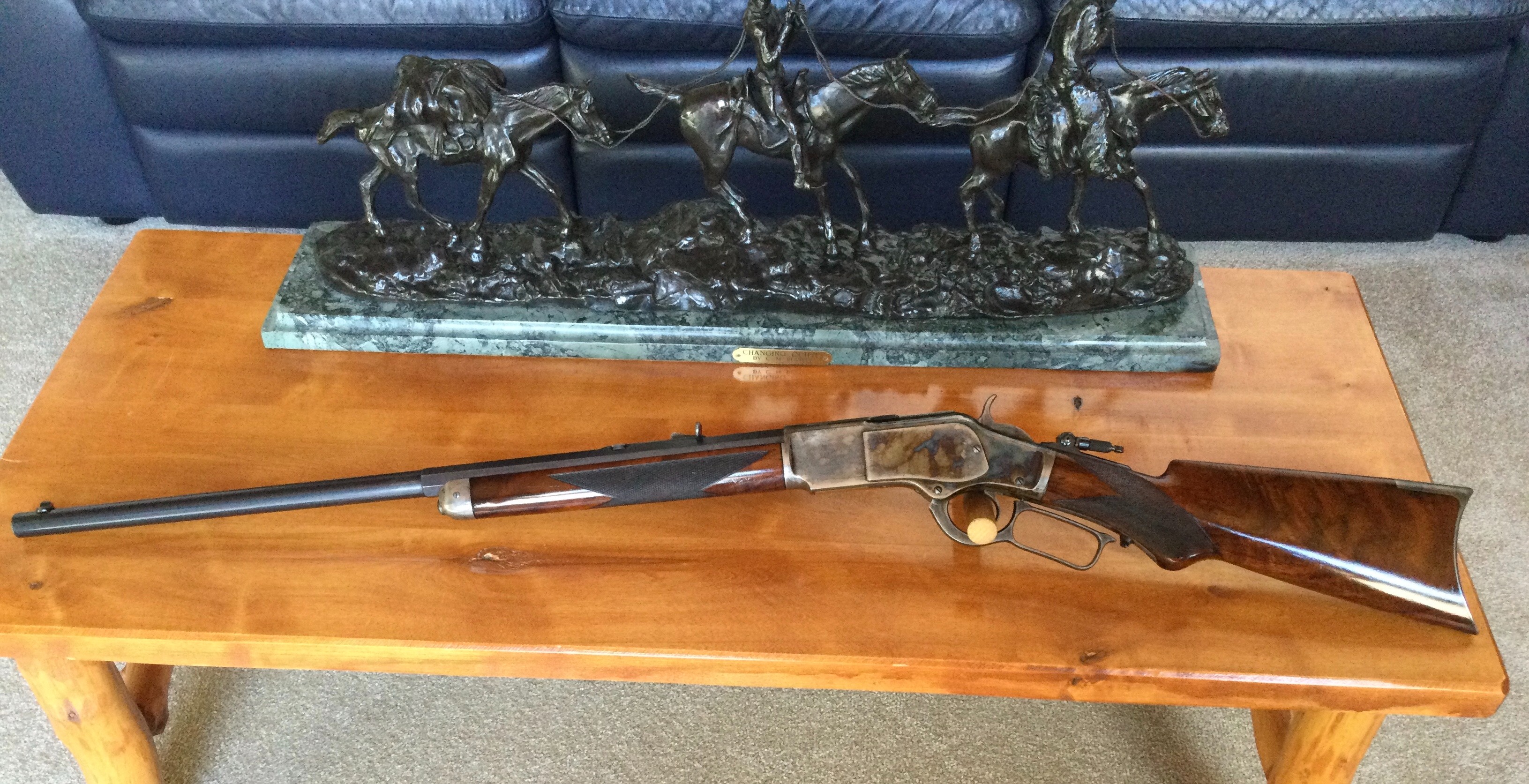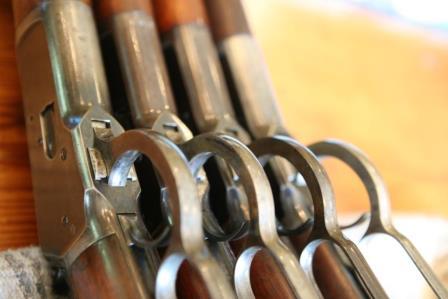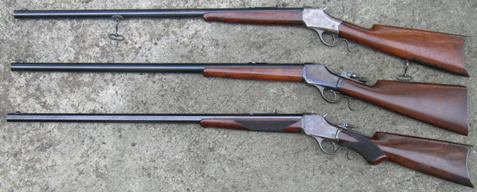TR said
If you consider chequered stock a deluxe then 84 per Herbert Houze Book. Nice gun, a 76 deluxe is a hard gun to find much less in a 50 plus the condition. You have a rare gun! T/R
Which Houze Book are you referring to? And what page?
Sincerely,
Maverick
![]()
WACA #8783 - Checkout my Reloading Tool Survey!
https://winchestercollector.org/forum/winchester-research-surveys/winchester-reloading-tool-survey/
He is referring to the chapter Houze’s “The Winchester Model 1876 Centennial Rifle” , page 129. Houze lists the number of 50 Express rifles with “Chequered Stocks” at 84 out of 3284 rifles in the 50 cal chambering. Interestingly, there are two that are listed as “Light Chequered Stock”. Not sure what that means.
1892takedown @sbcglobal.net ......NRA Endowment Life Member.....WACA Member
"God is great.....beer is good.....and people are crazy"... Billy Currington
I also find interesting on the previous page, the count for 22″ round barreled is 1,196. Where the 26″ octagonal is only 894. So was the 26″ barrel really the standard size for 50-95 or was it the 22″ popped into my head? But when you combine the number of 26″ round, half-round, & octagon you get 1,856.
But I knew from looking at the 50-95 over the years and noticed a lot with 22″ barrels. Glad to see this in Houze’s book.
Sincerely,
Maverick
![]()
WACA #8783 - Checkout my Reloading Tool Survey!
https://winchestercollector.org/forum/winchester-research-surveys/winchester-reloading-tool-survey/
Maverick said
I also find interesting on the previous page, the count for 22″ round barreled is 1,196. Where the 26″ octagonal is only 894. So was the 26″ barrel really the standard size for 50-95 or was it the 22″ popped into my head? But when you combine the number of 26″ round, half-round, & octagon you get 1,856.
The best that I can figure is the 26″ was the standard barrel length as recommended by Winchester for the best performance, however the 22″ were more popular. Madis suggests in his book the 26″ barrel length was standard.
The excerpt from Houze’s 50 Express Rifle chapter starts with a quotation from a Winchester pamphlet that is pure advertising genius. The cartridge was developed “To meet the wants of the hunter who needs a weapon having absolute killing power but not necessarily long range”. The bullet was a “hollow point that is fitted with a copper cup and modeled after the famous English Express bullets.” The next sentence of the pamphlet states “The results obtained in the use of this cartridge are, 1st, a large, dangerous, bone crushing, blood-letting wound with a prostrating shock, securing thus large game that a small, though perhaps deep wound, might escape, or require a second or third shot”. Man, got to love that line especially if your a big or dangerous game hunter, and does peak the curiosity. Suspect the 22″ would have been more popular if used as intended for dangerous game. A shorter barrel (and shorter magazine) means better portability, lighter, and quicker to point of aim. The cartridge was not intended for long ranges as the pamphlet quote states having “An initial velocity of 1641 ft., and a flat trajectory or essentially a point blank range of 150 to 200 yards…”
I packed a 45-60 with 30″ barrel for a while one deer season. After about the half first mile or so you begin to wonder why you packed the magazine full of cartridges and begin to think about that 1894 carbine you normally carry thats back at the house.
1892takedown @sbcglobal.net ......NRA Endowment Life Member.....WACA Member
"God is great.....beer is good.....and people are crazy"... Billy Currington
A lot of the 22″ barrel guns had round barrel, 1/2 magazine, shotgun butt, and British proof marks. This was the time that big dangerous game hunting was going on in the British Empire, I can see the appeal of a repeater over a double rifle. My personal experience shooting the 22″ barrel in the dark was like a Roman Candle, “fire out the barrel”, I don’t think the powder was done burning when it came out the barrel. The 26″ barrel is the right length for a 50-95 unless your into pyrotechnics. T/R
November 7, 2015
 Online
OnlineVery, very nice! Ammo is the only problem but in your place I’d get set up to cast & load for this little boomer if it broke me.
Mike
I don’t know if this will answer any questions or just muddy the water. In 1879, if you wanted to order a standard 1876 model Winchester sporting rifle in the “new” .50-95 Express, you had two choices, either a round or octagon barrel, both of which were 26″ in length. This was the standard barrel length for the .50 Express in the 1876 model. Anything other than 26″ barrel was a special order. I don’t cotton much to Houzes book on this model, but be that as it may, I will say that most (but not all) of the Express guns with 22″ round barrels, button mags and shotgun butts, were ordered by British gun companies and shipped by them to their colonies in Africa and India. The vast majority of these 22″ rifles will have British proof marks and many will have company markings, such as Holland and Holland or other English and India retailers names. I’ve shot several buffalo over the past few years, most with original 1876 Winchester rifles or carbine from my collection. I can say without a doubt, that the .45-75 performs much better that the .50 Express within the same range.
This is SN 39930. It was shipped with the nearly identical SN 39929 (24 inch barrel, otherwise the same) to order 11491 on April 29, 1884. SN 39929 was previously known to be in the Robert R. Vance collection. I don’t know it’s whereabouts now.
I believe the rear sight on 39930 is a replacement. It’s an Express rear sight which doesn’t show up in the catalog until later in the 1880’s. I think the front sight is original. No set screw. Previously in the Walt Hallstein, Burns, and Vern Vossler (Calgary, Alberta) collections. Documentation that came with it said it was originally owned by James Farquharson MacCleod who was second commissioner of the NWMP from July 22, 1876 – October 31, 1880. In 1887 was appointed to the Supreme Court of the Northwest Territories. Might be a wopper of a story, but that’s what came with the rifle.
Previously in the Walt Hallstein, Burns, and Vern Vossler (Calgary, Alberta) collections. Documentation that came with it said it was originally owned by James Farquharson MacCleod who was second commissioner of the NWMP from July 22, 1876 – October 31, 1880. In 1887 was appointed to the Supreme Court of the Northwest Territories. Might be a wopper of a story, but that’s what came with the rifle.
I call myself a collector as it sounds better than hoarder
Bill Hockett said
This is SN 39930. It was shipped with the nearly identical SN 39929 (24 inch barrel, otherwise the same) to order 11491 on April 29, 1884. SN 39929 was previously known to be in the Robert R. Vance collection. I don’t know it’s whereabouts now.I believe the rear sight on 39930 is a replacement. It’s an Express rear sight which doesn’t show up in the catalog until later in the 1880’s. I think the front sight is original. No set screw.
Previously in the Walt Hallstein, Burns, and Vern Vossler (Calgary, Alberta) collections. Documentation that came with it said it was originally owned by James Farquharson MacCleod who was second commissioner of the NWMP from July 22, 1876 – October 31, 1880. In 1887 was appointed to the Supreme Court of the Northwest Territories. Might be a wopper of a story, but that’s what came with the rifle.
Thanks for sharing this Bill – What a gun!

This is for SN 39929.
WINCHESTER MODEL 1876 – SERIAL NUMBER 39929
Serial number application date not available
Type: Rifle
Caliber: Express
Barrel Type: Round
Barrel Length: 24 inches
Trigger: Plain
Checkered stock, Pistol Grip
Sights: Platina front and rear
1/2 Magazine
Shotgun Butt, Rubber butt plate
Casehardened
Engraved etc.
Matted barrel
Received in warehouse on April 29, 1884
Shipped from warehouse on April 29, 1884, Order number 11491
I call myself a collector as it sounds better than hoarder
1 Guest(s)


 Log In
Log In Members
Members Home
Home

 Add Reply
Add Reply Add Topic
Add Topic Offline
Offline






















